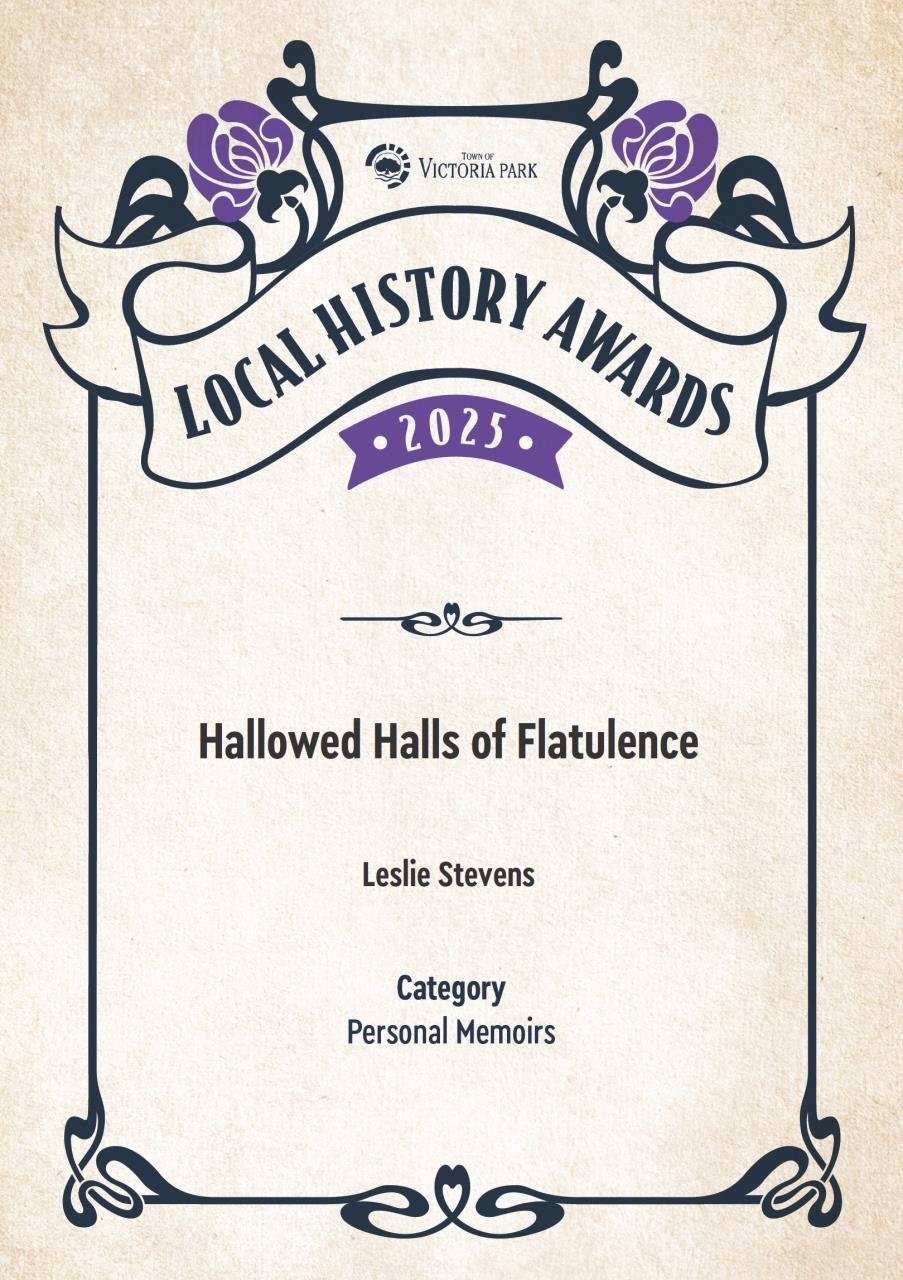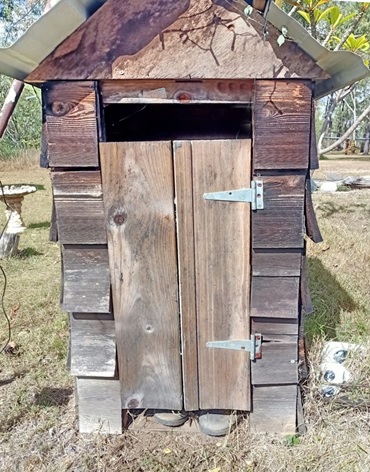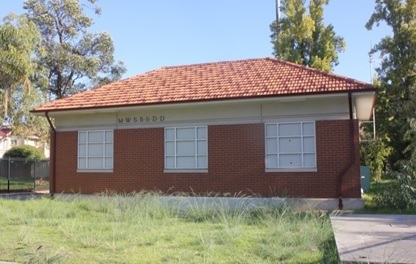Published on Tuesday, 30 September 2025 at 9:41:06 AM
It’s #TimeWarpTuesday, and we are continuing our ‘digital exhibition’ of entries into the Local History Awards with another entry in the Personal Memoirs category. Leslie Stevens brings us a hilarious look at the history of the once ubiquitous little shed that lived down the back fence.
Personal Memoirs
The Hallowed Halls of Flatulence
By Leslie Stevens
-Part One–
I realise that that some people may consider this a subject, which is not really in good taste. But like it or lump it, “Dunnies” were an integral part of our daily lives, in Victoria Park, as well as in most other areas, in decades past. Every residence had one! So even though they were usually “down the backyard”, out of sight, and out of mind, they did exist. And in their own way, were a part of the history, of the early Victoria Park families too. So I consider it worthwhile, to make some mention of them. Mainly because quite a few of the present younger generations, would have never seen one, or even knew that they existed. So for the sake of “posterior-ority” I wrote this story. It is a “Bum“ story, I know, but there you have it, because that was what it was all about!
|

Exhibition cover page for Leslie’s entry in the Personal Memoirs category of the 2025 Local History Awards
Local History Collection, Town of Victoria Park Library Service
|

[Les Stevens'] Niece Sandra's Queensland 'Dunny' (complete with boots).
Courtesy of Les Stevens
|
In the days when I was just a child, an indoor toilet was a thing of luxury and generally only afforded, by the rich folk. This meant that in those days, most toilets were relegated to external locations. Even with the advent of sewerage, a lot of the toilets still remained out of doors. Although they were slightly more refined, in that they had glazed China toilet bowls, rather than a simple metal can, and could be flushed, by pulling the chain, on an overhead Cistern. I can imagine that a visit to the toilet, down at the bottom of the yard, at night in those days, would be most daunting for a young child.
Which usually resulted, in the frequent use, during the night, of what was known as the family “Poe” or “Gzunda” whatever you like to call it!
“Gzunda” was short for “Goes Under” the Bed”. It was an item, that was well used by the family. Particularly on winter nights, when the weather was a little inclement!
Toilets that were not so blessed, with the availability of sewerage, were usually located on the rear fence line of the property. In those early times, in such locations, not served by sewerage, a laneway existed, between the rows of houses. Adjacent to their rear fence lines. This was to facilitate easy access, to the workers, who had the onerous task, of removing the toilet waste, on a weekly basis. Each toilet had a hinged wooden flap, on its external rear wall, that opened onto that laneway, to allow this to happen.
The truck that carted this human waste away, became known in the local idiom, as the “Dunny Cart”, and the waste was politely referred to, as “Night Soil”. The vehicle they used was thus, also referred to as the “Night or “Dunny Cart”. Which, in itself was a bit of an anomaly, because the removal of said waste, was made during daylight hours. So understandably, the workers, who carried out this onerous task, became known as “Night Carters”. In this day and age, they could possibly have been referred to as W.D.M’s. Or “Waste Disposal Managers”.
These “Night Carters” were employees of a Western Australian Government department, which was commonly identified, by the Acronym M.W.S.S. & D.D. This stood for, the Metropolitan Water Supply, Sewerage and Drainage Department. These letters can be seen, on the building, in the photograph below. But it has since simply become known as, the Water Corporation. A lot of the items used by them, in past decades, carried the M.W.S. logo. You can still see that in places, particularly on some old concrete drainage products.
But the word “Metropolitan” in its title, became redundant, and the name was changed to simply be the Water Corporation. Mainly because it had the responsibility, for the provision and maintenance, of all those services, throughout the state. The Water Corp. also maintains and controls most major state water storage, and sewerage facilities. Accounts for services rendered, to the householder, are issued by them, roughly every two months.
The job these “Night Carters” were employed to do, was to drive along those laneways, between the houses, lift the rear lid of the toilets, and remove the “used” toilet cans. Then, place a secure lid on it, and stack it on the flat bed, of their truck, with all the others, so collected. Having done that, they then put a replacement empty can, back into the toilet, and shut the lid again, and moved on to the next “Dunny”.
When the truck was thus laden with “full” cans, it was then driven to a Sewerage treatment plant, where the cans were emptied, and possibly hosed clean. Another load of empty cans taken on board, and the process repeated. These “Dunny” cans were circular in shape and made of steel.
They were about the size, of half a 12 gallon oil drum. They probably stood about 40 cm high, and were about the same in diameter. They resembled a very large boiling pot, and like those, possessed two handles on the sides, for ease of handling, and loading, on and off the truck. The standard disinfectant, to counteract the smell and discourage the Blowflies, that the householders used at the time, was Phenyle.
The subject of “Night Carting”, was also the butt of many jokes. One which comes readily to mind, from my memory banks, was in the form of a question. It asked “What has 24 Cylinders and Flys?” The answer of course, was the “Night Cart”! Making reference to the metal cans it carried, and the ever present, Blow flies!
Also from my childhood memories, I remember a sewerage treatment facility, down near the intersection of Hordern and Armagh Streets, near the Causeway, in Vic Park. There were also the remnants, of a sewerage treatment area, which I knew of, on Burswood Island. It was locally referred to, as the “Filter Beds”. That, from memory was located roughly, just to the south, of where the Optus Stadium now stands, but all traces of it have long since been removed. I know that, that particular location was there, but not in operation, when I was a teenager, in the mid to late 1950’s. So, I am assuming that the Swan River floods of the 1930’s, that inundated much of Burswood Island, made its position on the Island untenable, and it fell into disuse.
But the establishment at Hordern Street, was definitely there, in the late 1940’s, when we lived close by, in Canning Highway. For that matter, it still remains there today, as the following photograph attests. I have distinct memories of an “outfall“ pipe, that emptied waste sewerage water, straight into the Swan river, directly opposite that plant. Little bits of human excreta, could often be seen floating in the river nearby.
These were jokingly referred to as Blind Mullet. These days, that wastewater though, is being utilized in several ways. In some cases, it is being totally purified, and fed back into our water supplies. Alternately it is being used to irrigate public gardens, parks, and or, golf courses. On one of my many travels, throughout Australia, I was informed that the fairways and greens, of the Golf course in Broken Hill, New South Wales, was irrigated with reconstituted wastewater. To the delight, of the local Emu, and Kangaroo populations.
Those 1930 floods also would have also probably inundated some residential areas of Victoria Park, around Garland and Stafford Streets, on the Swan River’s eastern shores. With all these old “Dunnies” in vogue, at that time, such flooding could have created a health hazard. So, the Government of that day, decided to reclaim all that land, and create an “A” class reserve in lieu. Thus, we then had McCullum Park and its once associated tennis courts.
My maternal grandparents, who lived in that area, were affected by these reclamations and subsequently moved, to a house in Rivervale. Their home, in Ascot Road, (later to become, Great Eastern Highway), Rivervale, had a back yard Dunny, constructed in wood with a tin roof. And the Night Cart system was still in vogue there, at that time. Their toilet was, located right at the back, of their property, on the rear fence line. A laneway ran between it, and the houses behind it. I have definite memories of that, being the situation there. And they had moved from Victoria Park to Rivervale, in the mid 1930’s, because of those floods. I seem to recall that their toilet was still down their back yard, in the late 1950’s, with the “Night Carters” still doing their weekly collections.
From memory, the toilet at our house in 58 Canning Highway, was located just behind the house, close to the northern fence line, and was connected to the local sewerage mains. I don’t recall what it was constructed of, but I am guessing it was kiln fired clay bricks.
I also, distinctly remember, that my Paternal Grandparents who lived opposite, at No.53, on the corner of Taylor St, at the time, had a brick built, redundant “dunny”, at the bottom of their back garden. But I can’t swear that it was still in use.
Early, metropolitan suburbia, meant that residential areas were laid out, in the form of rectangular grids. Houses faced both sides of the streets, which were parallel, to one another. These houses formed the long sides of the rectangle. Other cross streets formed the short sides of the rectangle. And open laneway’s, ran between the houses, that faced the parallel streets, from one cross street to another. These laneways, thus allowed the “Night Carters” access to the back yard toilets, along the rear fence lines. Some residents also used these lanes, to gain vehicular access, to their own back yards.
-End of Part One-
We hope you are enjoying this look back at this little piece of our daily lives that is usually covered in euphemisms and not often discussed. Be sure to check back next week for Part Two, the final part of the story of the backyard ‘dunny’.
Don’t forget we are always happy to accept donations of photographs, memorabilia and stories about the suburbs within our Town. Don’t hesitate to get in touch with us via telephone: 08 9373 5500, email: vicparklibrary@vicpark.wa.gov.au or in person at 27 Sussex Street, East Victoria Park.
#LoveVicPark
|

|
The Sewerage Depot At Western End Of Hordern St Victoria Park, May 2023
Courtesy of Leslie Stevens
|
Back to All News